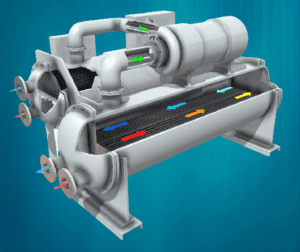Types of heat exchanger is a mechanical device designed to efficiently transfer thermal energy (heat) from one fluid to another fluid, without allowing them to mix or come into direct contact. Heat exchangers are used in various industrial, commercial, and residential applications to either heat or cool a fluid or maintain temperature, making them essential components in heating, ventilation, air conditioning, power generation, and many other processes. These devices play a vital role in conserving energy, optimizing efficiency, and controlling temperature in diverse systems and applications.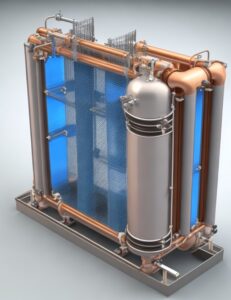
A heat exchanger is a mechanical device designed to facilitate the efficient transfer of heat energy between two or more fluids that are at different temperatures. The primary purpose of a heat exchanger is to either heat or cool a fluid, depending on the specific application, while preventing the mixing of these fluids.
Shell-and-Tube Heat Exchanger Technical Specifications:
- Tube Thickness: The tube thickness is typically determined by engineering calculations, considering factors such as fluid pressure, temperature, and material properties. Common tube thicknesses can range from 1.2 mm to 5 mm or more, depending on the application.
- Pressure Rating: The pressure rating of a heat exchanger is closely related to the shell thickness and material. It specifies the maximum pressure the heat exchanger can safely handle. Common pressure ratings range from 150 PSI to 1500 PSI or higher, depending on design and usage.
- Design Pressure: The design pressure is the pressure at which the heat exchanger is designed to operate safely. It takes into account factors like safety margins and potential transient pressure spikes. Design pressures can vary widely but often fall within the range of 200 PSI to 600 PSI or more.
- Pipeline Sizes: The pipeline sizes connected to the heat exchanger are determined by the process flow rates, fluid properties, and design specifications. These sizes can vary significantly based on the specific application but typically range from 1 inch to 12 inches or more in diameter.
- Shell Thickness: The shell thickness is critical for ensuring the structural integrity of the heat exchanger under the specified operating conditions. Shell thickness is determined based on pressure, temperature, material, and design standards. Typical shell thicknesses can range from 3 mm to 20 mm or more.
- Material of Construction (MOC): The material of construction for both the shell and tubes depends on the fluids being processed and environmental factors. Common materials include carbon steel, stainless steel (e.g., 304, 316), copper, and various alloys (e.g., Inconel, Titanium). The selection is made to ensure corrosion resistance, thermal conductivity, and mechanical strength.
- Size: Heat exchanger sizes can vary widely, from small units used in residential HVAC systems to large industrial heat exchangers used in power plants and chemical processing facilities. Size is determined by factors like heat transfer requirements and available space.
These technical specifications provide essential information for the design, fabrication, and safe operation of a shell-and-tube heat exchanger. The specific values for these parameters would depend on the unique requirements of the heat exchanger’s intended application and the engineering standards and codes followed by the manufacturer.
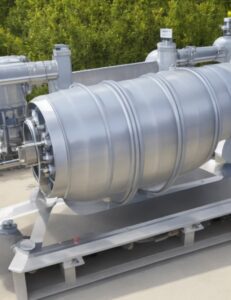
Components of the Heat Exchanger
| Component | Description | Details/Specifications |
| Shell | Outer cylindrical housing of the heat exchanger. | Diameter: Varies based on design and application. Material: Selected based on fluid compatibility and strength. Thickness: Determined by pressure and design standards. |
| Tubes | Tubular elements within the shell for fluid flow. | Diameter: Typically ranges from 8 mm to 50 mm or more. Length: Varies based on heat transfer requirements. Material: Chosen based on fluid properties and corrosion resistance. Thickness: Depends on design parameters and material choice. |
| Tube Sheets | Plates that support and seal the ends of the tubes. | Material: Often made from the same material as the shell. Thickness: Designed to provide structural support and sealing. |
| Baffles | Plates or spacers inside the shell that promote turbulence for efficient heat transfer. | Configuration: Segmented, full, or partial baffles as per design. Spacing: Determined based on heat transfer requirements. Thickness: Sufficient to provide support and promote fluid mixing. |
| End Caps/Headers | Enclosures at both ends of the shell to connect to inlet and outlet pipes. | Material: Usually made from the same material as the shell. Thickness: Designed to handle pressure and temperature requirements. |
| Pass Partitions | Dividers within the shell to direct fluid flow in multiple passes. | Number and configuration depend on design and performance objectives. Material: Matches the material of other internal components. |
| Gaskets and Seals | Sealing materials to prevent leakage between components. | Material: Typically made of gasket materials compatible with the fluids and temperature conditions. Thickness: Sized to ensure a proper seal. |
| Nozzles/Connections | Inlet and outlet ports for hot and cold fluids. | Size: Determined by pipeline sizes and flow rates. Material: Matches the material of headers/end caps. Flange Standard: Follows industry standards like ANSI or DIN. |
| Insulation | Thermal insulation to reduce heat loss and improve efficiency. | Material: Various insulation materials such as fiberglass or foam. Thickness: Depends on desired insulation properties. |
| Support Structure | Frame or support system to hold the heat exchanger in place. | Material: Typically steel or another sturdy material. Design: Ensures stability and structural integrity. |
Heat exchangrs play a crucial role in various industrial, commercial, and residential processes, enabling the efficient utilization of thermal energy. They are found in a wide range of applications, including:
Heating Systems:
Heat exchangrs are commonly used in residential and commercial heating systems. They transfer heat from a hot fluid (often water or steam) to the air, warming indoor spaces.
Cooling Systems:
In air conditioning and refrigeration systems, heat exchangrs remove heat from the indoor environment and release it outside, cooling the indoor space.
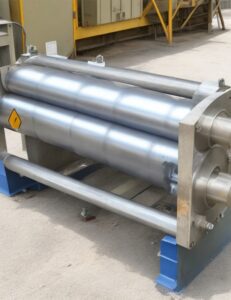
Power Plants:
Heat exchangrs are integral components in power generation facilities. They help convert thermal energy (from sources like steam or gas) into electricity by transferring heat from high-temperature fluids to lower-temperature working fluids.
Industrial Processes:
Various industries, such as chemical, petrochemical, and food processing, rely on heat exchangrs to control temperatures during manufacturing processes. They are essential for tasks like pasteurization, condensation, and evaporation.
Automotive:
Heat exchangrs, such as radiators and intercoolers, are used in vehicles to regulate engine temperature and improve the efficiency of combustion engines.
Renewable Energy:
Heat exchangers are employed in renewable energy systems, like solar water heaters and geothermal heat pumps, to harness and distribute thermal energy efficiently.
The basic principle of a heat exchangr involves placing two or more fluids in close proximity to each other without direct mixing. This allows heat to transfer from the hotter fluid to the colder one. Heat exchangrs can have various designs, including shell and tube, plate, finned-tube, and more, each suited to specific applications based on factors such as heat transfer efficiency, pressure drop, and material compatibility.
In summary, a heat exchangr is a vital engineering component that enables the controlled exchange of thermal energy between fluids, making it possible to heat or cool processes, spaces, or systems efficiently while maintaining the integrity of each fluid.
Types of Heat Exchanger:
Heat exchangrs come in various types, each designed for specific applications and offering distinct advantages. Here are some of the most common types of heat exchangrs:
Shell and Tube Heat Exchanger:
- Design: Consists of a large cylindrical shell with multiple tubes running through it.
- Applications: Widely used in industrial processes, power plants, and HVAC systems.
- Advantages: High heat transfer efficiency, durability, and versatility.
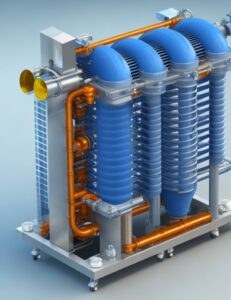
Plate Heat Exchanger:
- Design: Comprises a series of thin metal plates stacked together, with alternating hot and cold fluid channels.
- Applications: Common in food and beverage, chemical processing, and HVAC industries.
- Advantages: Compact design, efficient heat transfer, and easy maintenance.
Finned-Tube Heat Exchanger:
- Design: Tubes with external fins to increase the surface area for heat exchange.
- Applications: Used in air conditioning, refrigeration, and some industrial processes.
- Advantages: Improved heat transfer efficiency, suitable for air-to-liquid and gas-to-liquid applications.
Double-Pipe Heat Exchanger:
- Design: Simplest form with two concentric pipes, one carrying hot fluid and the other cold.
- Applications: Common in small-scale applications, laboratory setups, and some HVAC systems.
- Advantages: Easy to install, low cost, and straightforward design.
Plate-Fin Heat Exchanger:
- Design: Compact and lightweight, featuring alternating layers of plates and fins.
- Applications: Used in aerospace, aviation, and some industrial processes.
- Advantages: High surface area for heat transfer, suitable for high-temperature applications.
Regenerative Heat Exchanger:
- Design: Utilizes rotating or oscillating matrix materials to store and transfer heat between hot and cold fluids.
- Applications: Found in regenerative thermal oxidizers, certain industrial processes, and energy recovery systems.
- Advantages: High thermal efficiency and energy savings.
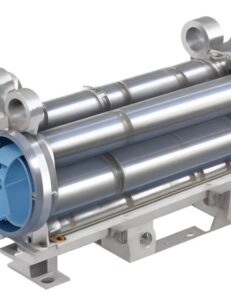
Air-to-Air Heat Exchanger (Heat Recovery Ventilator – HRV/ERV):
- Design: Designed to transfer heat between incoming and outgoing air streams in HVAC systems.
- Applications: Used in residential and commercial buildings to improve indoor air quality and energy efficiency.
- Advantages: Recovers heat in winter and coolness in summer, reducing heating and cooling costs.
Hybrid Heat Exchanger:
- Design: Combines two or more types of heat exchngers to maximize efficiency.
- Applications: Customized solutions for specific applications where standard designs may not suffice.
- Advantages: Tailored to meet unique requirements, potentially offering superior performance.
Plate-Fin Tube Heat Exchanger:
- Design: Combines the principles of plate and finned-tube exchangers for enhanced heat transfer.
- Applications: Common in the automotive industry, particularly for engine and transmission cooling.
- Advantages: Efficient heat transfer, compact design, and lightweight.

